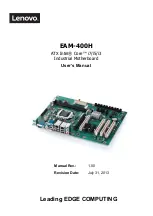
Motherboard Installation
Page 4
[A] PS/2 Keyboard / Mouse Connectors
PS/2 device, likes some PS/2 keyboard and mouse, are all have a standard 6-pin round shape
connector. The benefit of PS/2 device is one of the serial port may be free for other serial device such
as writing table. On this motherboard, there are two on-board PS/2 connectors, one for keyboard and
one for mouse, which saves your money to buy any optional PS/2 connector module. If you are using a
PS/2 mouse or keyboard, you can simply plug into the corresponding connector without any jumper
setting.
[B] USB Connectors
Universal Serial Bus (USB) is new interface standard for any I/O device “Outside the Box”. USB
makes your peripherals have a real plug and play (PnP) capabilities with up to 12Mb/sec data speed In
the coming soon, any external device connected to your computer will be standardized into USB
standard which are all have a special 4-pin rectangle shape connector. Therefore, with the Intel
chipset, this motherboard builds two USB connectors on-board for you future investment.
[C] External I/O Connectors
Based on the ATX standard, two 9-pin serial ports and one 25-pin parallel port are now built on the
motherboard back panel, too! This design makes your motherboard’s installation more easily. The
parallel port can be BIOS configured into standard (SPP) mode, Enhanced Parallel Port (EPP) mode,
and a high speed Extended Capabilities Port (ECP) compatible mode. EPP Mode requires a driver
provided by the peripheral manufacturer in order to operate correctly.
[D] PENTIUM II
®
CPU CARD Slot
The CPU card slot, slot 1, is a 242-pin slot design for PENTIUM II
, single edge contact cartridge,
along with a programmable voltage regulator for the CPU core. It provides users with a performance
upgrade path to PENTIUM II
®
OverDrive technology. The motherboard built-in a switching voltage
regulator which supports from 2.1V to 3.5V PENTIUM II
processors. The regulator makes use of the
VID capabilities to automatically adjust its voltage output to match that of the installed processor,
which eliminated the traditional jumper settings.
PENTIUM II
PROCESSOR CARD
The PENTIUM II
processor integrates second level cache and cache controller that
was previously implemented on the motherboard. The internal non-blocking L2 cache
on the processors card is 512k KB cache.
The PENTIUM II
®
processor card maintains full backward compatibility with the
8086, 80286, Intel386
TM
, Intel486
TM
and Pentium
®
processors. It also has a numeric
coprocessor that significantly increases the speed of floating point operations, while
maintaining backward compatibility with the i486DX math coprocessor and complying
with ANSI/IEEE standard 754-1985.
[E] Accelerated Graphic Port (AGP)
The AGP is compatible with the Accelerated graphics port specification. The AGP offers a much
higher throughput over the PCI bus does. PCI currently only supports 33Mhz can transport 133MB/s
at peak rates over its 32bit data bus. AGP is clocked with 66Mhz, which enables a peak rate of 266
MB/s at the classic so called ‘X1’ mode. If using the ‘X2’ mode, it can transport up to 532MB/s at
peak rate.


































